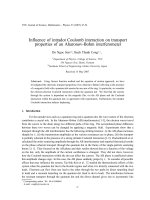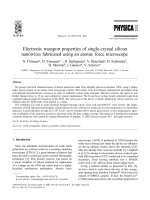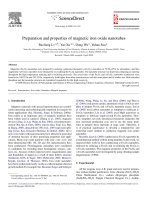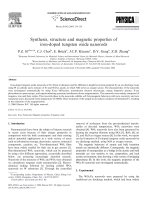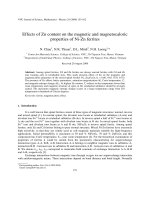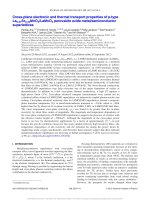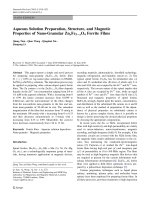Structure, magnetic and transport properties of magnetic oxide materials and exploration of magnetic oxides semiconductor (zno) heterostructures
Bạn đang xem bản rút gọn của tài liệu. Xem và tải ngay bản đầy đủ của tài liệu tại đây (6.64 MB, 175 trang )
STRUCTURE, MAGNETIC AND TRANSPORT PROPERTIES OF
MAGNETIC OXIDE MATERIALS & EXPLORATION OF MAGNETIC
OXIDES\SEMICONDUCTOR (ZnO) HETEROSTRUCTURES
HUANG XUELIAN
(B.E., UNIVERSITY OF SCIENCE AND
TECHNOLOGY, BEIJING, CHINA)
A THESIS SUBMITTED FOR THE DEGREE OF DOCTOR OF
PHILOSOPHY
DEPARTMENT OF MATERIAL SCIENCE AND ENGINEERING
NATIONAL UNIVERSITY OF SINGAPORE
2012
DECLARATION
I hereby declare that the thesis is my original
work and it has been written by me in its entirety.
I have duly acknowledged all the sources of
information which have been used in the thesis.
This thesis has also not been submitted for any
degree in any university previously.
HUANG XUELIAN
19 DEC 2012
I
ACKNOWLEDGEMENTS
I feel deeply indebted to several people who have contributed in different ways towards the work
accomplished in this thesis.
First and foremost, I would like to express my heartfelt appreciation to my supervisor Prof Ding
Jun in Materials Science and Engineering Department (MSE) of National University of
Singapore (NUS) for his guidance, inspiration, and encouragement throughout the course of my
research. The novel and creative ideas inspired by Prof Ding were indispensable to my research
during the period of my PhD candidature. Whenever I was in the bottleneck, he always guided
me with great patience. Without his guidance and commitment, definitely, I cannot finish my
thesis.
Besides, I would like to thank Dr Yi Jiabao, who guided me in experimental work. He also
helped me revise my manuscripts and gave valuable comments. I would also like to express
my apparition to Ms Bao Nina and Dr Zhang Jixuan for SQUID measurement and TEM imaging.
Moreover, I would like to acknowledge my research group members: Dr Herng Tun Seng,
Dr Zhang Lina, Dr Ma Yuwei, Mr Yang Yong, Ms Li Tong, and Ms Yang Yang, Ms Li Weimin
and Ms Lv Yunbo.
In addition, I would like to acknowledge National University of Singapore (NUS) for
providing me the financial support an excellent research environment.
Last but not least, I really appreciate the unceasing support, faith and advice from my
parents in China. Special thanks to my friend He Yihan, Tang Chunhua, Lv Weilai and Ho Pin
for proof-reading as well as for their consistently reliable support.
II
SUMMARY
The emerging field of spintronics has spurred renewed interest in the magnetic and spin
dependent transport properties of magnetic oxide materials with a high degree of spin
polarization. A research into the unique properties of magnetic oxides is one of the most
important issues for the spintronics application. Besides, the semiconductor spintronics
integrating memory and logic into a single device makes the investigation of magnetic oxides /
semiconductors heterostructures for spin injection appealing. This thesis mainly focused on
fabricating different magnetic oxides thin films, investigating mechanisms for thin film growth
and magnetic property, as well as the exploration of possible heterostructures. The contribution
of the work is summarized as below:
(1) Investigations indicated that the strain plays an important role in determining the
microstructure, magnetic and transport properties of the magnetic oxide thin films.
(2) A whole picture of the structure and magnetic properties of half metallic magnetite
(Fe
3
O
4
) thin films deposited on different substrates by PLD in amorphous, textured and
epitaxial state with different orientations was described. It was found that strong (111)-
texture can be obtained on a variety of substrates no matter they have either a huge lattice
mismatch or no matching at all with Fe
3
O
4
. The (111)-epitaxial Fe
3
O
4
film with a strong
in-plane compressive strain was achieved on single crystal Al
2
O
3
(sapphire). Significant
out-of-plane magnetization components were observed in Fe
3
O
4
/Al
2
O
3
as a consequence
of the in-plane compressive strain. In addition, very high saturated magnetization
(680emu/cc) of the (001)-epitaxial ultrathin films deposited on (001) MgO substrate was
achieved. The magnetic and transport properties analysis demonstrated that the substrate-
III
induced strain significantly affects the magnetic anisotropy and the magnetic coupling at
the anti-phase boundaries in the films.
(3) Iron based magnetic spinel oxide materials for the spin-filtering devices were investigated.
High quality spinel ferrites thin films such as MnZn-Fe
2
O
4
and CoFe
2
O
4
with unique
properties were achieved. The ultrathin MnZn-Fe
2
O
4
film with highly textured structure
on glass substrate possessed an enhanced magnetization; the ~30nm CoFe
2
O
4
films with
the largest strain was blessed with large out of plane anisotropy with Hc
as large
as 10
KOe. The growth of textured structure and the magnetic anisotropy was attributed to the
substrate induced strain. In addition, epitaxial γ-Fe
2
O
3
films with a magnetic moment
close to the bulk value of 400 emu cm
−3
was achieved onto (001) or (110) MgO
substrates inasmuch the substrate template effect. The spinel structure of the ultrathin γ-
Fe
2
O
3
films was maintained even if the films underwent a high temperature annealing.
The thermodynamic consideration describing the epitaxial stabilization phenomenon was
presented for understanding the grown mechanism.
The obtained ultrathin films, both ferrites and γ-Fe
2
O
3
have a quite flat surface and high
resistivity. These results indicated that it is possible to deposit high quality ultrathin
magnetic oxide films by PLD, which paved a promising way for the applications in spin
filter devices.
(4) The perovskite SrRuO
3
thin films as ferromagnetic electrode were investigated. Greatly
enhanced perpendicular coercivity over 2 Tesla in nanocrystalline SrRuO
3
thin films on
quartz substrates was obtained compared to epitaxial thin films on (001) SrTiO
3
and (001)
LaAlO
3
substrates. It was shown that a lattice strain may result in reduced Curie
temperature and enhanced saturation magnetization. The spin glass like behaviors was
IV
observed in the nanocrystalline thin films. The augment of the coercivity is possibly
associated with nanocrystalline nature and the spin glass like phenomena in the films.
(5) The last part of this thesis extended the study to investigate the possible heterostructures
formed by the magnetic oxides and conventional semiconductors (ZnO). Epitaxial bilayer
structures of (111) Fe
3
O
4
/ (0001) ZnO on single crystal (0001) Al
2
O
3
substrates, (111)
CoFe
2
O
4
/ (0001) ZnO on single crystal (110) SiO
2
substrates and (11-20) ZnO/ (001)
SRO on (001) STO substrates were achieved. High quality crystalline films with sharp
interfaces, and rms surface roughness less than 1 nm were achieved. Magnetization
measurements showed clear ferromagnetic behavior of the magnetite layer with
saturation magnetization of 380emu/cc at 300 K. CoFe
2
O
4
/ ZnO exhibited a large out of
plane anisotropy due to the nanocrystallized (111) texture and the residual strain. The
results demonstrated that the magnetic oxide and ZnO system, such as Fe
3
O
4
/ ZnO,
CoFe
2
O
4
/ ZnO and ZnO / SRO, is an intriguing and promising candidate for the
realization of multifunctional heterostructures.
V
PUBLICATIONS
1. X.L. Huang, Y. Yang, J. Ding “Formation of epitaxial γ-Fe
2
O
3
thin films on MgO substrates
by Pulsed laser deposition” Acta Materialia 61, 548 (2013).
2. X.L. Huang, M. Eginligil, H. Yang, J. Ding “Augment of coercivity in nanocrystalline SrRuO
3
thin film and its spin glass behavior” Journal of Magnetism and Magnetic Materials (accepted).
3. X.L. Huang, Y. Yang, J. Ding “Structure and magnetic properties of Fe
3
O
4
thin films on
different substrates by Pulsed Laser Deposition” Journal of Korean Physical Society (accepted).
4. W. M. Li, X. L. Huang, J. Z. Shi, Y. J. Chen, T. L. Huang and J. Ding “Angular dependence
and temperature effect on switching field distribution of Co/Pd based bit patterned media”
Journal of Applied Physics 111, 07B917 (2012).
5. Y. W. Ma, X. L. Huang, X. Liu, J. B. Yi, K. C. Leong, Lap Chan, T. Li, N. N. Bao, J. Ding,
“Magnetic and transport properties of n-type Fe doped In
2
O
3
and ZnO films” Nanoscience and
Nanotechnology Letters 4, 641 (2012).
6. C.H. Ong, T.S. Herng, X.L. Huang, Y.P. Feng, J. Ding, “Strain-Induced ZnO Spinterfaces”
The Journal of Physical Chemistry C 116 (1), pp 610–617 (2012).
7. H. Waqas, X.L. Huang, J.B. Yi, J. Ding, H.M. Fan, Y.W. Ma and T.S. Herng, A.H. Quresh,
J.Q. Wei, D.S. Xue “Highly Textured Growth of Mn
1-x
Zn
x
Fe
2
O
4
Film on Glass Substrate”
Journal of Applied Physics 107, 09A514, (2010) .
8. Q. Q. Ke, W. L. Lv, X. L. Huang, J. Wang “Highly (111)-Orientated BiFeO
3
Thin Film
Deposited on La
0.67
Sr
0.33
MnO
3
Buffered Pt/TiO
2
/SiO
2
/Si (100) Substrate” Journal of The
Electrochemical Society 159, G11-G14 (2012).
9. Y. W. Ma, J. Ding, W. S. Liu, J. B. Yi, C. M. Ng, N. N. Bao, and X. L. Huang “Structural and
magnetic properties of ZnO nanocrystals in (Zn, Al)O film using pulse laser deposition” Journal
of Nanoscience and Nanotechnology 11(3), 2628-3 (2011).
10. Y. Yang, J. B. Yi, X. L. Huang, J. M. Xue, J. Ding, “High-Coercivity in alpha-Fe
2
O
3
formed after annealing from Fe
3
O
4
nanoparticles” IEEE TRANSACTIONS ON MAGNETICS 47,
2159487 (2011).
11. J. B. Yi, C. C. Lim, Y. P. Feng, J. Ding, G. Z. Xing, H. M. Fan, L. H. Van, S. L. Huang, K. S.
Yang, X.L. Huang, X.B. Qin, B.Y. Wang, T. Wu, L. Wang, H. T. Zhang, X. Y. Gao, T. Liu, and
A. T. S. Wee “Ferromagnetism in Diluted Magnetic Semiconductors through Defect Engineering:
Li-doped ZnO” Physical Review Letters 104, 137201 (2010).
VI
12. Y. W. Ma, J. Ding, L. Chan, J. B. Yi, T. S. Herng, S. Huang, X. L. Huang, “Room
Temperature Ferromagnetism in (Zn
(1-x)
, Mg
(x)
)O Film” IEEE TRANSACTIONS ON
MAGNETICS 46, 2040066 (2010).
13. T. Li, H.M. Fan, J.B. Yi, T.S. Herng, Y.W. Ma, X.L. Huang, J.M. Xue and J. Ding
“Structural and magnetic studies of Cu-doped ZnO films synthesized via a hydrothermal route”
Journal of Materials Chemistry 20, 5756–5762 (2010).
VII
TABLE OF CONTENTS
ACKNOWLEDGEMENTS I
SUMMARY II
PUBLICATIONS V
TABLE OF CONTENTS VII
LIST OF TABLES XI
LIST OF FIGURES XII
Chapter 1 Introduction 1
1.1 Oxides in spintronics 2
1.1.1 Highly spin-polarized oxides (half metallic oxides) 2
1.1.2 Oxides for spin filtering 4
1.1.3 Diluted magnetic oxides 6
1.2 Magnetite (Fe
3
O
4
) and derivatives 8
1.2.1 Spinel structure of Fe
3
O
4
and Verwey transition 9
1.2.2 Antiphase boundaries in Fe
3
O
4
thin films 11
1.2.3 Spinel ferrites 13
1.2.4 Maghemite (γ-Fe
2
O
3
) 15
1.3 Strontium ruthenate (SrRuO
3
) 17
1.3.1 Crystal structure 17
1.3.2 Magnetic properties of the SrRuO
3
thin film 19
1.4 Growth, texture, strain effect of the magnetic oxide thin films 19
1.4.1 Texture evolution 20
1.4.2 Strain formation in thin films 21
1.5 Motivation and Objectives 23
REFERENCES: 27
Chapter 2 Thin film Preparation and Characterization Techniques 31
2.1 Thin film deposition: pulse laser deposition (PLD) 31
2.1.1 Set-up of PLD system 31
2.1.2 Mechanism of film growth using PLD 33
VIII
2.2 Structural characterization 36
2.2.1 X-ray diffraction (XRD) 36
2.2.2 Atomic force microscopy (AFM) 39
2.2.3 Transmission electron microscopy (TEM) 41
2.2.4 X-ray photoelectron spectroscopy (XPS) 45
2.2.5 Raman spectroscopy 46
2.2.6 Profilometer 47
2.3 Magnetic property characterization 47
2.3.1 Vibrating sample magnetometer (VSM) 47
2.3.2 Superconducting quantum interface device (SQUID) 49
REFERENCES: 51
Chapter 3 Fe
3
O
4
thin films grown on different substrates 52
3.1 Introduction 52
3.2 Experimental 53
3.3 The (111) oriented Fe
3
O
4
on different substrates 54
3.3.1 Structure characterization 54
3.3.2 Phase identification using XPS and Raman spectra 59
3.3.3 Magnetic and transport properties 61
3.3.4 Summary 63
3.4 Epitaxial (002) Fe
3
O
4
on (001) MgO substrate 64
3.4.1 Structure characterization 64
3.3.3 Magnetic properties 67
3.3.4 Summary 70
3.5 Summary 70
REFERENCES: 72
Chapter 4 Study of different spinel ferrite thin films 74
4.1 Introduction 74
4.2 Growth of highly textured manganese zinc ferrite films 75
4.2.1 Experimental 75
4.2.2 Effect of Temperature 76
IX
4.2.3 Effect of Thickness 78
4.2.4 Effect of laser power 80
4.2.5 Summary 81
4. 3 Growth of CoFe
2
O
4
thin films 82
4.3.1 Experimental 82
4.3.2 Structure characterization 82
4.3.3 Magnetic property 89
4.3.4 Summary 94
4.4 Summary 94
REFERENCES: 95
Chapter 5 Epitaxial growth of γ-Fe
2
O
3
thin films on MgO substrates 97
5.1 Introduction 97
5.2 Experimental 98
5.3 Formation of phase(s) and substrate effect 99
5.4 Properties of γ-Fe
2
O
3
thin film 112
5.5 Summary 117
REFERENCES: 119
Chapter 6 Nanocrystalline SrRuO
3
thin film and its spin glass behavior 121
6.1 Introduction 121
6.2 Experimental 122
6.3 Structure characterization 123
6.4 Magnetic and transport properties 126
6.5 Summary 133
REFERENCES: 135
Chapter 7 Exploration of ferromagnetic oxides/semiconductor (ZnO) multifunctional
heterostructures 137
7.1 Introduction 137
7.2 Experimental 139
7.3 Fe
3
O
4
/
ZnO & CoFe
2
O
4
/ ZnO 140
7.4 ZnO / SrRuO
3
144
X
7.5 Summary 149
REFERENCES 151
Chapter 8 Conclusion and Future work 152
8.1 Summary of results 152
8.2 Recommendations for future work 155
XI
LIST OF TABLES
Table 1. 1. Spinel ferrites and their structure depending on site occupency. 14
Table 3. 1. Summary of the electric and magnetic properties of the magnetite (Fe
3
O
4
) thin films
(40nm) on different substrates. 58
Table 3. 2. In plane strain, Saturated magnetization (Ms), Coercivity (Hc) and Resistivity of the
Fe
3
O
4
films on (001) MgO substrates with different thicknesses. 69
Table 4. 1. Strain, and magnetic properties (Coercivity Hc, remenance ratio) of the CoFe
2
O
4
films on glass substrates with a thickness of 100nm deposited at different temperatures. 91
Table 4. 2. Strain, and magnetic properties (Coercivity Hc, remenance ratio) of the CoFe
2
O
4
films deposited at 350°C on SiO
2
substrates with different thicknesses. 92
Table 5. 1. Resistivity of the γ-Fe
2
O
3
of the as deposited thin film and after annealing; thickness
dependent saturated magnetization and coercivity of the as deposited (350˚ C, 500 ˚ C) and after
annealing γ-Fe
2
O
3
thin films, measurement was conducted both at 300K and 5K. 116
XII
LIST OF FIGURES
Figure 1. 1. The density of state of non-magnetic, ferromagnetic, and half metallic meterials. 4
Figure 1. 2. Schematic diagram of Spin filter tunneling. Below the T
C
of the ferromagnetic
tunnel barrier, the barrier height for tunneling electrons depends on the relative spin orientation.
Spin up electrons tunnel far more easily than spin down, and a highly spin polarized current
results. 5
Figure 1. 3. Schematic diagram of the unite cell of spinel structure. 10
Figure 1. 4. A typical schematic diagram for the APBs in magnetite Fe
3
O
4
.[47] 13
Figure 1. 5. Schematic diagram of SrRuO
3
crystal structure in orthorhombic unit cell. The inner
cube constructed by thick solid lines is the pseudo-cubic unit cell.[67] 18
Figure 2. 1. Schematic diagram of PLD system. 32
Figure 2. 2. Schematic diagram of thin film condensation process. 35
Figure 2. 3. Schematic diagram of Bragg’s law. 37
Figure 2. 4. Schematic diagram of the AFM 40
Figure 2. 5. Schematic diagram of diffraction and imaging mode of the TEM[10]. 42
Figure 2. 6. Schematic diagram of the bright field mode for TEM. 43
Figure 2. 7. Schematic diagram of the dark field mode for TEM. 44
Figure 2. 8. Schematic diagram of VSM set-up. 48
Figure 3. 1. a) XRD spectra of iron oxide thin film with oxygen pressure 1x10
-6
torr on glass
substrates with different deposition temperatures; b) Magnetization VS Temperature curve of the
magnetite films on glass substrates with different deposition temperatures. 56
Figure 3. 2. XRD spectra of iron oxide thin film deposited at 350 °C with oxygen pressure 1x10
-
6
torr on glass substrates with different laser power, 160mJ and 240mJ. 56
Figure 3. 3. XRD spectra of iron oxide thin film deposited at 350 °C with oxygen pressure 1x10
-
6
torr on Si, SiO
2
, and glass substrates, which have large lattice mismatch or no matching with
the Fe
3
O
4
films. 57
Figure 3. 4. a)XRD spectra of iron oxide thin film deposited at 350 °C with oxygen pressure
1x10
-6
torr on Al
2
O
3
substrate, the inset is the rocking curve; b) phi scan of the along the (311)
direction of the Fe
3
O
4
film. 58
XIII
Figure 3. 5. XPS spectra of the iron oxide thin films deposited on Si, glass, SiO
2
and Al
2
O
3
substrate at 350 °C under oxygen partial pressure 1x10
-6
torr. 60
Figure 3. 6. The Raman shift spectra of the Fe
3
O
4
films deposited on substrates of glass, Si, and
Al
2
O
3
. 61
Figure 3. 7. Room temperature hysteresis loops (in plane and out of plane) of iron oxide films
(40 nm) deposited at 350 °C onto a) Si and b) (0001) Al
2
O
3
substrate under oxygen partial
pressure 1x10
-6
Torr. 62
Figure 3. 8. Magnetoresistance vs field curve of the Fe
3
O
4
film (40nm) grown on Al
2
O
3
substrate with magnetic filed parallel and perpendicular to the film. 63
Figure 3. 9. XRD spectra of the Fe
3
O
4
(10nm) on (001) MgO substrates, the inset is the high
resolution spectrum to differentiate the (004) Fe
3
O
4
peak from the substrate signal. 65
Figure 3. 10. Reciprocal space mapping (RSM) spectra of the Fe
3
O
4
(10nm) on (001) MgO
substrate, along (002) and (-203) directions. 65
Figure 3. 11. XPS spectra of the Fe
3
O
4
with different thicknesses of 10nm and 50nm on (001)
MgO, repectively. 66
Figure 3. 12. The hysteresis loops of the ultrathin Fe
3
O
4
film (10nm) measured at a) 5K and b)
300K. 68
Figure 3. 13. FC-ZFCcurve of the Fe
3
O
4
with different thicknesses a) 10nm, b) 30nm, c) 50nm,
on (001) MgO. 69
Figure 4. 1. a) XRD spectra of manganese zinc ferrite deposited at different temperatures. The
inset is the small scale of peak (311); b) The saturation magnetization and coercivity dependence
on the substrate temperature of the films deposited at different temperatures. 77
Figure 4. 2. a) TEM image of manganese zinc ferrite film deposited at 268
o
C. The inset is the
SAED of the film; b) In-plane and out of plane of hysteresis loop of manganese zinc ferrite film
deposited at 268
o
C with a thickness of 60 nm. The inset is the angular dependence of coercivity.
78
Figure 4. 3. a) XRD spectra of manganese zinc ferrite films with different thicknesses (substrate
temperature 268
o
C); The inset is the small scale of peak (311); b) The dependence of saturation
magnetization and coercivity on film thickness (substrate temperature 268
o
C). The inset is the
hysteresis loop of the film with a thickness of 9 nm (498
o
C). 79
XIV
Figure 4. 4. XRD spectrum of manganese zinc ferrite film deposited with a very low deposition
rate (0.5 nm/min). The inset the small scale of peak (311); 80
Figure 4. 5. XRD spectra of the CoFe
2
O
4
films with a thickness of 100nm deposited at different
temperature on glass substrates. 84
Figure 4. 6. XRD spectra of the CoFe
2
O
4
films with different thicknesses (18nm, 50nm, 120nm,
300nm) deposited at a substrate temperature 350°C on glass substrates. 85
Figure 4. 7. Raman shift of the CoFe
2
O
4
films with different thicknesses. 88
Figure 4. 8. AFM images of the CoFe
2
O
4
films deposited at a) Room Temperature, b) 350°C,
and c) 550°C on SiO
2
substrates; d) 350°C on glass substrate. 89
Figure 4. 9. In plane (black) and out of plane (red) hysteresis loops of CoFe
2
O
4
deposited at
temperatures from 150°C, 250°C, 350°C and 550°C on glass substrates. 90
Figure 4. 10. In plane (black curve) and out of plane (red curve) hysteresis loops of the CoFe
2
O
4
films with a thickness of 30nm on SiO
2
substrate. 92
Figure 5. 1. Phases presented in dependence of oxygen partial pressure (P (O
2
)) and deposition
temperature (T), when iron oxide films deposited on (001) and (110) MgO substrates (a) ; and on
glass, X-cut quartz or (0001) sapphire substrates (b). Amor: amorphous like structure; Dis:
disordered structure consisting with the amorphous like structure with small α-Fe
2
O
3
grains in
Fig. 5.2f. 100
Figure 5. 2. XRD spectra of the iron oxide thin films (20 nm) deposited on glass substrates
under different oxygen partial pressures: a) 2x10
-6
torr at 350 ˚C, b) 2x10
-5
torr at 350 ˚C, c) 2x10
-
3
torr at 350 ˚C and d) 2x10
-3
torr at 500˚C. e) The magnetization trend of the films in a, b, c, d,
respectively; f) TEM image of iron oxide thin films deposited in 2x10
-3
torr, 350 ˚C
(corresponding to XRD spectrum in Fig. 5.2c)). 102
Figure 5. 3. a) XRD spectra of iron oxide thin film grown at 350 °C with oxygen pressure 1x10
-3
torr onto (001) MgO substrate; insets are the small scale spectra. b) Phi scan of the iron oxide
thin film grown at 350 °C with oxygen pressure 1x10
-3
torr on (001) MgO substrate. 104
Figure 5. 4. a) XRD spectra of iron oxide thin film grown at 350 °C with oxygen pressure 1x10
-3
torr onto (110) MgO substrate; insets is the small scale spectrum b) the small scale spectra of
(220) peak of γ-Fe
2
O
3
films with various thickness. 104
Figure 5. 5. XPS spectra of the iron oxide thin films on (001) MgO substrates deposited under
different oxygen partial pressure: a) 1x10
-6
torr (Fe
3
O
4
); b) 1x10
-3
torr, (γ-Fe
2
O
3
). 106
XV
Figure 5. 6. Temperature dependence of magnetization after cooling in zero field (ZFC) and in a
field of 500Oe (FC) of a) iron oxide thin films deposited at 1x10
-6
torr (Fe
3
O
4
) and b) 1x10
-3
torr,
(γ -Fe
2
O
3
) on (001) MgO substrates. 107
Figure 5. 7. Resistivity (left, red) and the saturated magnetization (right, black) of iron oxide
thin film (20 nm) grown at 350 °C onto (001) MgO substrate in dependence of oxygen pressure.
108
Figure 5. 8. Resistivity (left, red) and the saturated magnetization (right, black) of iron oxide
thin film (20 nm) grown with oxygen pressure 1x10
-3
torr onto (001) MgO substrate in
dependence of deposition temperature 109
Figure 5. 9. The saturated magnetization of iron oxide films with varied thicknesses deposited at
350 °C onto (001) MgO substrate with oxygen partial pressure 1x10
-3
Torr; magnetization per
volume(left, blue), magnetization per area(right, cyan) 110
Figure 5. 10. a) TEM image of 80 nm γ-Fe
2
O
3
thin
film deposited at 350 °C on (001)MgO
substrate. The corresponding high resolution TEM image of the film at b) interface, c) near
bottom (<50nm), inset is the live FFT (Fast Fourier transform) pattern, d) near the surface
(>50nm). 111
Figure 5. 11. Selected AFM images of the a) MgO substrate, b) 5nm, and c) 120nm epitaxial γ -
Fe
2
O
3
films; d) the corresponding rms roughnesses of the substrate and films with different
thicknesses. 113
Figure 5. 12. Room temperature hysteresis loops of iron oxide films (20 nm) deposited at 350 °C
onto a) (110) MgO and c) (001) MgO substrate with oxygen partial pressure 1x10
-3
Torr; the
corresponding remanence ratio (Mr/Ms) and Coercivity (Hc) of the samples, b) (110) MgO, d)
(001) MgO. 115
Figure 6. 1. a) XRD spectra of the SrRuO
3
film (60nm) grown at 600°C on (001) SrTiO
3
substrate; b) Reciprocal space maps (RMS) spectra and c)The high resolution TEM, along (001)
of the epitaxial SrRuO
3
films grown on SrTiO
3
substrate. 124
Figure 6. 2. a) XRD spectra of the SrRuO
3
film (60nm) grown at 600°C on z-cut quartz; b) TEM
bright field image and related SAED pattern of the SrRuO
3
film on quartz; (c) dark field image
of the same area. 125
XVI
Figure 6. 3. AFM images of the nanocrystalline and epitaxial SrRuO
3
thin films deposited on z-
cut quartz (a), and SrTiO
3
(b) substrates. The corresponding root-mean-square roughness of the
films (2µm x 2µm) are 1.15nm, 0.42nm, respectively. 126
Figure 6. 4. The in plane and out of plane hysteresis loops at 5K of the SrRuO
3
thin films
deposited on z-cut quartz (a), and (001)SrTiO
3
(b) substrates, respectively. 128
Figure 6. 5. The out of plane hysteresis loops of the SrRuO
3
films grown on z-cut quartz with
different thicknesses, a) 9 nm b) 15nm. 129
Figure 6. 6. The Field Cooling (FC) magnetizations as a function of temperature of SrRuO
3
films on quartz substrate with a thickness of a) 60nm and b) 9nm; The solid line on FC
magnetizations is the curve fitted with M ∝ (Tc –T)
β
. 130
Figure 6. 7. Zero Field Cooling (ZFC) curves of 60 nm SrRuO
3
film on quartz by applying a
variety of magnetic fields from 0.01T-3T. The inset shows the curve of the applied field (H)
versus the temperature in the cusp (T
F
) of the ZFC curves as a function of H
23
. The straight lines
are linear fit to the Bloch’s law. 132
Figure 6. 8. a) The out of plane hysteresis loops of the 60nm SrRuO
3
film taken at different
temperatures (below Tc), b) the elicited variation of Hc and Ms with temperature. 133
Figure 7. 1. Schematic diagrams of the heterostructures prepared by the PLD system. 140
Figure 7. 2. XRD spectra of the Fe
3
O
4
/ZnO/Al
2
O
3
. The insets are the Rocking corves for the
reflection of (002) ZnO (red curve) and (111) Fe
3
O
4
(black cueve), respectively. 141
Figure 7. 3. In plane and out of plane hysteresis loops of the Fe
3
O
4
/ZnO heterostructure. 142
Figure 7. 4. XRD spectra of the CoFe
2
O
4
/ ZnO /SiO
2,
and
the enlarged (333) diffraction of the
CoFe
2
O
4
films
with different thicknesses. 143
Figure 7. 5. In plane and out of plane hysteresis loops of the CoFe
2
O
4
(40nm) / ZnO on (110)
SiO
2
substrate
.
144
Figure 7. 6. a) XRD spectra of the ZnO/SRO bi-layers on LAO substrates. The SRO bottom film
was prepared under the same condition (550°C, 20 mtorr). The ZnO layer were prepared at
different temperatures. b) The RMS spectra of the ZnO/SRO/LAO. 145
Figure 7. 7. Schematic illustration of the (11-20) ZnO plane and the epitaxial relation between
the (11-20) ZnO and (001) SRO bottom electrode. 146
XVII
Figure 7. 8. a) Cross section TEM image ZnO/SrRuO
3
heterostruture on LAO substrate and b)
the corresponding high resolution TEM image of the SRO/ZnO interface, inset is the live FFT
(Fast Fourier transform) pattern. 147
Figure 7. 9. AFM image of a) the SRO films and b) ZnO films deposited on SRO layer at
500°C. 148
Figure 7. 10. Room-temperature PL spectrum of ZnO/SrRuO
3
hesterstructure. 149
Chapter 1 Introduction
1
Chapter 1 Introduction
In conventional electronic devices, the “spin” property of electrons has not been put into any
practical use. Spin electronics (spintronics),[1,2 ]is an emerging technology which is devoted to
manipulating electron spin to create electronic devices with novel or superior characteristics, and
it has attracted considerable attention in recent years. The ‘spintronics’ devices have the
potential merits of non-volatility, higher data processing speed, less power consumption and
higher integration density due to a simpler device structure.
The origins of spintronics can be traced back from discoveries of spin-dependent electron
transport phenomena in solid-state devices in the 1980s. This includes the observation of spin-
polarized electron injection from a ferromagnetic metal to a nonmagnetic metal by Johnson and
Silsbee (1985),[3] and the discovery of giant magnetoresistance by Albert Fert et al. [4]and Peter
Grünberg et al.[5] (1988). Another milestone for the spintronics is the theoretical proposal of a
spin field-effect-transistor by Datta and Das [ 6 ] (1990), which opens the gate for the
investigation of semiconductors for spintronics.
So far, the most extensively applied spintronics devices are based on giant magnetoresistance
(GMR) effect and tunnel magnetoresistance (TMR) effect. They are widely used in read heads
for hard disk drives [7] and magnetic random access memories (MRAM),[8,9] which exploit the
existence of the two non volatile resistance states. The ferromagnetic materials primarily used in
first generation spintronics devices are 3d transition metals such as Fe, Ni, Co and their alloys. In
the diffusive limit, the spin polarization for these materials is always positive and typically close
to 40%. The magnetic oxide materials with high degree of spin polarization are expected to be
superior to metals, as they could provide enhanced spin-dependent transport phenomenon.
Chapter 1 Introduction
2
Indeed, spin-dependent conductance has been observed in transport across a macroscopic
interface between two ferromagnetic oxide elements by controlling the relative orientation of the
elements in a relatively small magnetic field. Since the first pioneering TMR results obtained on
tunnel junctions based on manganese perovskite oxides [10], the interest for oxides in spintronics
has increased at a quick pace.
This Chapter presents an in-depth overview of high spin polarization oxide materials and
their specific applications, then followed by detail study of some specified magnetic oxide
materials, which focuses on ferrimagnet Fe
3
O
4
and its derivates (spinel ferrite and gamma Fe
2
O
3
),
metallic ferromagnet SrRuO
3
. The rest of the review is devoted to the growth methods, structure
and the strain effect in growing the magnetic oxide materials.
1.1 Oxides in spintronics
Magnetic oxides form an interesting class of candidate materials for stronger spin polarization,
which have been explored for their novel properties in spintronics. The first approach is to use
the fully spin polarized oxides as ferro-or ferri-magnetic electrodes in magnetic tunnel junctions.
The second approach consists in synthesizing new ferromagnetic oxides with high Curie
temperatures by doping non-magnetic semiconducting oxides with magnetic ions. A third, less
explored, approach to obtain a strong spin polarization is to use a tunnel barrier of a ferro- or
ferrimagnetic oxide: this is the spin filter concept.
1.1.1 Highly spin-polarized oxides (half metallic oxides)
Chapter 1 Introduction
3
The spin dependent conduction in spintronics devices such as spin field effect transistors,[6] spin
valve read heads[11] and non- volatile magnetic random access memory,[8] depends strongly on
the spin polarization of the ferromagnetic materials constituting these devices. The spin
polarization (P) of the material is defined by the equation:
Eq.1.1
Where E
F
is the Fermi level, N is the density of states of majority () or minority
electrons at
the Fermi level. Figure 1.1 shows the density of states (DOS) of a non-magnetic metal and a
magnetic metal. Since the number of spin up () and spin down
electrons are equal in the
non-magnetic metals, the net spin polarization P= 0. However, for the magnetic metals, the DOS
at E
F
is splitting, thus resulting a net spin polarization ( .
Conventional ferromagnets are based on the 3d transition metals, such as Fe, Co, Ni and their
alloys. Even though the 3d band is strongly spilt, the conduction electrons are still not fully spin
polarized since the present of the un-split 4s electrons at the E
F
. In 3d transition metals, the spin
polarization is always positive and close to 40%.
The ‘half-metallic’ material has an unusual band structure in which only half of the electrons are
conducting. Only one type of electrons (spin or spin) is present at the Fermi level. In this case,
the polarization is equal to 100%. The existence of this new class of magnetic materials was
discovered by Froot et. al.[12] in 1983. It has to be mentioned that the definition of the half
metallicity in terms of band structure can only be strictly applied at 0K. The concept of half
metallicity can be extended to materials in which the spin up electrons are localized and the spin
down electrons are delocalized or vice versa.
Chapter 1 Introduction
4
Figure 1. 1. The density of state of non-magnetic, ferromagnetic, and half metallic meterials.
Most of the half metallic materials are ferromagnetic oxides, such as CrO
2
, Fe
3
O
4
, and
La0.
7
Sr
0.3
MnO
3
(LSMO). The highly spin-polarized property has made them the focus of recent
fundamental and technological studies in the field of spin electronics. In practical applications,
the operation temperature should be around or above room temperature. This necessitates the
Curie temperature (Tc) of the material to be greater than 500K.[13] The Fe
3
O
4
is the most
promising candidate for incorporation with the spintronics devices for it has the highest curie
temperature (Tc=860K) compared with other candidates such as CrO
2
(Tc=395K) and
La0.
7
Sr
0.3
MnO
3
(Tc=360K).
1.1.2 Oxides for spin filtering
The concept of spin filter relies on the use of a ferromagnetic or ferrimagnetic insulating tunnel
barrier. In an insulating Ferro- or ferrimagnetic oxide, the exchange splitting of the conduction
Chapter 1 Introduction
5
bands results in a different barrier height for spin-up and spin-down electrons. As described in
Figure 1.2, the combination of a non-magnetic electrode, which acts as an electrons source, with
a ferromagnetic barrier yields two very different currents for spin-up and spin-down electrons
due to the different transmission for these two spin directions and thus resulting a strongly spin
polarized current. Such a combination makes it possible to artificially reproduce a half-metal.
Figure 1. 2. Schematic diagram of Spin filter tunneling. Below the T
c
of the ferromagnetic
tunnel barrier, the barrier height for tunneling electrons depends on the relative spin orientation.
Spin up electrons tunnel far more easily than spin down electrons, and a highly spin polarized
current results.
One of the most difficulties encountered in spin filtering is synthesizing a very thin oxide layer
with the proper electrical and magnetic properties. The first experiments validating this filtering
concept were carried out by Moodera's group [14] using europium chalcogenide (EuS) barriers.
However, the low Curie temperature of this material (Tc=16 K) excludes it from applications.
Chapter 1 Introduction
6
Then, certain insulating oxides with higher Curie temperatures have been studied. Among these,
europium oxide EuO (Tc=69 K) as a barrier has been measured, showing a spin polarization of
conduction electrons of 29% at very low temperature (T=0.4 K).[15] TMR effects have also been
obtained with ferromagnetic barriers of BiMnO
3
(Tc=105K) and La
0.1
Bi
0.9
MnO
3
by the
CNRS/Thalès joint research unit,[16,17] who found spin polarizations of conduction electrons of
respectively 22% and 35%, but still at very low temperature. Another family of oxides is
currently offering new perspectives for the measurement of TMR effects at room temperature.
These are insulating ferrites with spinel structures, of chemical formula AFe
2
O
4
, where A is a
divalent ion of a transition metal (Ni
2+
, Co
2+
, etc.), and whose Curie temperatures are higher than
room temperature. TMR effects were measured at very low temperatures (4 K) in MTJs with
tunnel barriers of nickel ferrite NiFe
2
O
4
[18] corresponding to a spin filter efficiency of 22%.
Despite a Curie temperature well above room temperature (T
c
= 850 K), integrating this oxide in
an MTJ caused spin filtering to disappear at room temperature, pointing to a need for further
work. More recently, Chapline and Wang [19] claimed the room temperature spin filtering
effects in cobalt ferrite (CoFe
2
O
4
). SPCSI and CNRS/Thalès’ group have reported room
temperature spin filtering in magnetic tunnel junctions (MTJs) containing CoFe
2
O
4
tunnel
barriers via tunneling magnetoresistance (TMR) measurements. [ 20 ] All these results
demonstrate the potential of this oxide for spin filtering.
1.1.3 Diluted magnetic oxides
Due to the advances of the spintronics and semiconductor science and technology, the
manipulation of the spin degree of freedom of electrons in semiconductors may become possible.
This may lead to novel devices with dual functionalities—processing information and storing

